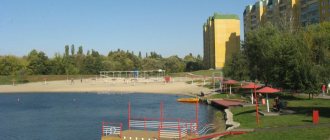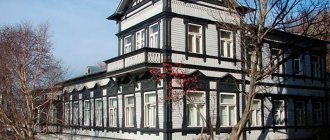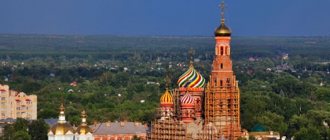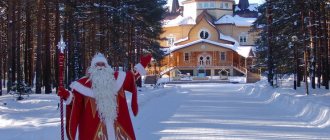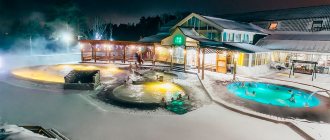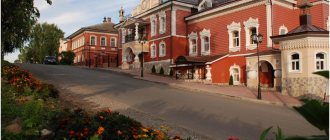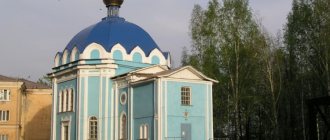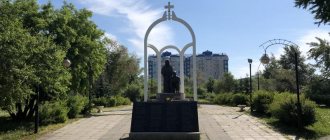| First day Second day Third day Alternative routes for day 3 Stories, routes and tips from tourists Where to stay in Volgograd Where to go from Volgograd for 3 days |
Volgograd is most often considered as a destination for a day trip or stops here on the way to other southern cities. However, it is worth staying here longer to feel the atmosphere of the hero city, almost completely rebuilt after the destruction of the Great Patriotic War. In addition to visiting the majestic monument “The Motherland is Calling!” and other war memorials, here you can get acquainted with the city's more ancient past.
Volgograd in 3 days is an opportunity to get to know the city not only as the site of the legendary Battle of Stalingrad. You will have time to walk along the streets that have preserved the appearance from the times when the city was called Tsaritsyn, visit the colony founded under Catherine II, and look at one of the largest hydroelectric power plants in Europe. Natural attractions in the vicinity of Volgograd are of interest; the journey to them will take from 3 hours, which is suitable for travelers staying here for several days.
Sculpture “The Motherland is Calling!” Photo: © Stanislav Kaznov
First day
It’s convenient to start exploring the historical center of Volgograd at Station Square, where the railway station is located. In front of it you will see the Barmaley fountain , made in 2013 in the image of a pre-war fountain. The composition with a round dance of children against the backdrop of destruction caused by air strikes appeared in a photograph from 1942 and made an indelible impression of the contrast of smiling children and the ruins of the city.
From the square, walk to several architectural monuments of pre-revolutionary times. On the street Gogol there is a red-brick mansion of the Repnikovs , which houses the Volgograd Memorial and Historical Museum with an exhibition about the Civil War. If you walk along Kommunisticheskaya Street, you will see the Tsaritsyn fire brigade building , restored according to the original of the 19th century.
Fire tower Photo: © Igor Butyrskii
Next, go to the Square of Fallen Fighters, past the monument to Alexander Nevsky and the New Experimental Theater in a building from the early 20th century. The Alexander Nevsky Cathedral , which was located on the Square of Fallen Fighters until it was blown up in the 1930s, is being rebuilt in the Alexander Garden It is worth walking along Volgodonskaya Street with several merchant houses of the late 19th century.
On the Square of Fallen Fighters you will see an obelisk to the defenders of Red Tsaritsyn near the grave of the Red Guards. Many people were also buried in the mass grave during the Great Patriotic War, and the Eternal Flame was lit in their memory. Not far from the grave of the Three Heroes there is a poplar tree that survived military battles. The green area with memorials is surrounded by post-war buildings. Don't be put off by Stalin's neoclassicism, in the style of which many buildings in the restored Stalingrad were built. The monumentality was intended to reflect the heroic and difficult times of the war. The central department store on the square was restored after the war and houses the Memory Museum . The exhibitions tell about the headquarters of the German commander F. Paulus located in the basement and his capture.
Details: Square of Fallen Fighters
In the Memory Museum Photo: © grau59
Along the Alley of Heroes you go to the central embankment named after the 62nd Army . First you will see the Art Fountain from 1957. Nearby there are two propylaea - structures with 8 columns, from which the central staircase . It connects the upper and lower tiers of the embankment. Steam shipping on the Volga actively developed at the beginning of the 19th century; many merchant ships stopped at the Tsaritsyn port, but the improvement of the area near the water began only at the beginning of the 20th century. Then a landslide practically destroyed the embankment, and the area along the river was redecorated again in the 1930s. After the war, restoration work began, which was completed by 1952. The staircase was built on the site of a military crossing; now during the holidays it is used as an amphitheater. There are various monuments on the embankment; pay attention to the Church of John the Baptist (2001), built on the site of the first stone church of Tsaritsyn.
In detail: embankment of the 62nd Army
Central staircase Photo: © Vasilina Babkovskaya
On the embankment there is the “Rodimtsev Wall” - a memorable place where Major General Rodimtsev’s division landed, which came to help in the battles for Stalingrad. Above it is the “Battle of Stalingrad” panorama museum with a large-scale painting about the defeat of the enemy at Stalingrad. In addition to the panorama, the museum’s halls display items related to the Battle of Stalingrad - personal belongings of the battle participants, photographs, weapons. Next to the futuristic museum building, the Gerhardt mill . This building was significantly damaged during the fighting, and its appearance continues to remind us of the destructive power of war. In front of the mill there is a second fountain, “Barmaley”, which against its background looks almost like a photo from the war years. It’s also worth going to Pavlov’s house , where our soldiers held the defense. The house was rebuilt after the battles, and a memorial wall was installed on it.
Details: Panorama Museum “Battle of Stalingrad”
Gerhardt's Mill Photo: © Maksim Starostin
What to see in Volgograd in 3 days? One of the “Seven Wonders of Russia” is Mamayev Kurgan . This is the main city attraction, consisting of a complex of objects “Heroes of the Battle of Stalingrad”. During the war, the height of the mound was called “Height 102.” Capturing and holding this height was of strategic importance for each side; it offered good visibility and shooting opportunities, so numerous heavy battles took place here. However, the feat of the defenders of Stalingrad made a turning point in the war. His memory is immortalized in a large-scale historical and memorial complex. The main object is the sculpture “The Motherland is Calling!” 85 m high. Together with it, the ensemble consists of several squares and sculptures, bas-reliefs, ruin walls, a memorial cemetery, and the Hall of Military Glory with the Eternal Flame.
More details: Mamayev Kurgan
Complex on Mamayev Kurgan Photo: © Vasilina Babkovskaya
You can get to Mamayev Kurgan by metrotram - this is a high-speed Volgograd tram, most of the stations of which are underground. Tourists recommend trips on the metrotram as one of the city's attractions. From Mamayev Kurgan you can go down to the Volgograd Arena stadium , built for the 2022 World Cup. For relaxation, you can stop in the central park of culture and recreation with attractions and a Ferris wheel.
Detailed advice on what to see in Volgograd in 1 day
Volgograd Arena Stadium Photo: © Sergey Makhinin
Historical and architectural monuments
There is a lot to see on the streets of the thriving city. In Volgograd, historical and architectural monuments are treated with care. The few historical buildings that managed to survive the war are kept in excellent condition, as are the architectural gems restored after its end.
Triumphal Arch of the Volga-Don Canal
- Address: Not far from Fedor Ushakov Alley. Transport stop "Volgo-Don Hotel".
Above the first lock of the canal, the opening of which in 1952 turned Volgograd into a city of five seas, rises a structure that amazes with its grandeur. The huge Arc de Triomphe, 40 m high, combines Romanesque architectural traditions with the pomp of the Stalinist Empire style. It not only glorifies the greatness of the labor feat of the Soviet people, who managed to raise a war-torn country from the ruins in just a decade, but is also an important engineering structure. The massive walls of the structure house the mechanisms by which sluicing is carried out.
Railway station building
- Address: Station Square, 1. Transport stop "Railway Station".
The city railway station, built at the end of the 19th century, was considered one of the architectural highlights of first Tsaritsyn and then Stalingrad. However, during the war it was almost completely destroyed. The restoration of the building, in which German prisoners actively participated, began almost immediately after the liberation of the city. The work was completely completed in 1954. The building is in the traditional style of those years and looks majestic. The central part of the building is decorated with a massive clock tower, ending with a high spire topped with a five-pointed star.
Tsaritsyn fire brigade building
- Address: st. Kommunisticheskaya, 5. Transport stop "Railway Station".
Another historical building, which once housed the fire brigade, allows you to understand the spirit of the architecture of pre-revolutionary Tsaritsyn. It exactly replicates the exterior of the structure, erected at the end of the 19th century. and destroyed, according to various sources, either in the 30s of the last century, or during the war. The elegant building made of red and white brick, with elegant entrance arches, colorful facade decoration, and a high tower topped with a spire, looks simply excellent. It was restored with special care in 1955 using surviving photographs and drawings.
Gerhardt's Mill
- Address: st. Chuikova, 47A. Transport stop "Lenin Square".
The dilapidated building of the mill, which belonged to the Gerhardt trading house before the revolution, is a silent reminder of the horrors of the war. Its collapsed roof, gaping window openings, and brick walls riddled with bullets and shell fragments seem to be crying out to the current generation, calling on them to do everything so that nothing like this happens again. They specifically decided not to restore the house. In front of it is a replica of the famous Barmaley fountain, captured in several films about the Battle of Stalingrad.
Fountain "Art"
- Address: Central embankment. Stop "Agency".
The “Art” fountain, which also has the unofficial name “Friendship of Peoples,” is considered a true decoration of the city’s Central Embankment. In the middle of a pool of complex configuration, lined with polished granite, rises a carved bowl topped with a pedestal. There is a composition of three bronze sculptures depicting dancing beauties dressed in folk costumes. Geysers of different heights shoot out from nozzles built into the bottom of the pool. Also, streams of water pour out from the open mouths of the mascots located on the sides of the pedestal. In the evenings, the fountain, built in 1957, becomes the center of a delightful light and sound show.
Second day
Start your next day's walk by visiting the building of the Cossack Theater of the late 19th century. This is a red brick building with stucco, erected by the merchant Shlykov. Since the beginning of the last century, it housed a women's gymnasium, then other educational institutions; after the war, the restored building was given over to a cinema, and in the 1990s to a theater.
Details: Cossack Theater
Cossack Theater Photo: © Natalia Semchina
From the theater you can walk to the Kazan Cathedral . The church was consecrated in 1899; at the end of the 1930s it was closed and turned into a bakery. The building was damaged during the war, restoration was completed by 1948, and in the 1950s the church became a cathedral. The brick building was built in pseudo-Russian style; inside it is worth seeing the paintings made in the middle of the last century.
Details: Kazan Cathedral
Kazan Cathedral Photo: © Natalia Semchina
Next, take the train or buses to the Old Sarepta Museum-Reserve . This is a former colony of Germans from Gerngut, founded in the 18th century. The complex includes more than 20 buildings, dungeons and a museum of Russian mustard. In the museum you can get acquainted with the history of the Herrnhuters and their life in Sarepta, learn how they contributed to the development of the settlement and its transformation into a significant scientific and economic site.
Details: Museum-Reserve "Old Sarepta"
Museum-Reserve “Old Sarepta” Photo: © Catou
From the museum, go to the industrial achievement of the times of the USSR - the first lock of the Volga-Don Shipping Canal named after Lenin . Ideas about the need to build a canal connecting the Volga and Don were voiced several centuries ago, but work was carried out only by 1952. The entrance to the lock is decorated with a majestic arch 40 m high. On one side of the first lock, a monument to Lenin on the site of the Stalin monument, its height - 57 m. Between the monument and the lock there is a walking embankment of the Krasnoarmeysky district. On the other side of the entrance to the canal, a monument to the rivermen of the Volga Military Flotilla , serving as a lighthouse. Those interested in the details of the creation and operation of the canal can go to the Museum of the History of the Volga-Don Shipping Canal , located nearby.
Returning to the city center, you can again visit the embankment of the 62nd Army, go to the river station and take an hour-long walk along the Volga. From the river you will see the sights you have visited along the embankment in a new way, and will also pass under the Volgograd “dancing” bridge . When it gets dark, walk along the Alley of Heroes illuminated to imitate the starry sky. In the evening, you can attend a concert, performance or other cultural event in the Loft 1890 space. It is located in a historical building from the time of Tsaritsyn, this is the only surviving premises of the Zhiguli beer warehouses of the late 19th century.
Detailed advice on what to see in Volgograd in 2 days
Arch of the first lock of the Volga-Don Shipping Canal Photo: © Natalia Semchina
Volgograd churches and cathedrals
Most of the city's churches were built in modern times. However, this does not make them any less magnificent. Getting to know the churches and cathedrals of the city will bring many pleasant moments to the inquisitive traveler.
Kazan Cathedral
- Opening hours: daily, from 7:00 to 19:00.
- Telephone.
- Website: https://www.volgograd-sobor.ru
- Address: st. Lipetskaya, 10. Transport stop “Ulitsa Kuznetskaya”.
The Kazan Cathedral, consecrated at the very end of the 19th century, is considered the most beautiful of the city churches. The magnificent church delights with the elegance of its architecture, characteristic of the eclectic pseudo-Russian style. Carved white cornices and openwork stucco molding stand out on the red facade of the building. It is interesting that in Soviet times the temple was closed only for a few years, and services there resumed immediately after restoration work was completed in 1948. The main relics of the cathedral, attracting thousands of pilgrims here, are the images of Nicholas of Myra, Alexander Nevsky and Luke of Crimea with reliquaries.
Church of All Saints
- Opening hours: daily, from 9:00 to 17:00.
- Telephone.
- Website: https://www.vseh-svjtih.cerkov.ru
- Address: Mamaev Kurgan, 4. Transport stop "Mamaev Kurgan".
At the end of the last century, city authorities made the long-awaited decision to build a temple on Mamayev Kurgan. When creating the project, the architect had to face a difficulty - the soil of the mound had insufficient density. The problem was solved with the help of 27 titanium piles, on which a structure with a central dome height of 32 m was erected. The five-domed quadrangle made of white brick fit perfectly into the composition of the memorial. Its gilded domes are similar to the helmets of ancient Russian knights, whose glorious traditions were continued by the defenders of Stalingrad. While viewing the church, pay attention to the unique icons of the Warrior John, Dmitry Donskoy and Alexander Nevsky, created from beads, as well as the elegant chandeliers covered with gilding.
Church of John the Baptist
- Opening hours: daily, from 8:00 to 18:00.
- Phone: +7 844 238‑09-55.
- Website: https://www.ioann-predtecha.ru
- Address: st. Krasnoznemenskaya, 2. Transport stop “House of Artist”.
An accurate reconstruction of the city's oldest church was consecrated in 2000, to the joy of Volgograd's many believers. Its predecessor, the Church of John the Baptist, which existed for about 340 years, was blown up by the Bolsheviks in 1932. During the war, the Nazis built a pillbox on the ruins of the temple, and after its completion, the remains of the foundation were demolished. The foundation stone of the new building was laid in 1995. Today the church, which embodies the best traditions of religious architecture of the Russian Middle Ages in its exterior, is considered one of the architectural landmarks of the city.
Topic: The best attractions of the Volgograd region
The third day
In three days, Volgograd will open up to you not only as a city with military history. After getting acquainted with the main memorials and visiting museums, you can travel outside the city.
Lake Baskunchak
Arriving in Volgograd for 3 days, tourists often go to see the salt lake Baskunchak (200 km from the city) in the neighboring Astrakhan region. Salt has been mined here for a long time, and now this place provides up to 80% of production in Russia. The area of the lake is 115 sq. km, a liter of water contains 300 g of salt. Rapa (water supersaturated with salt) and local mud are used for medicinal baths. The lake looks very unusual and impressive. It is part of the Bogdinsko-Baskunchaksky Nature Reserve ; it is worth looking at the lake by climbing Mount Bolshoye Bogdo . The mountain at its base is a salt dome covered with sandstone, limestone, and clay. It rises above Baskunchak by more than 150 m.
Details: Lake Baskunchak
Lake Baskunchak Photo: © mut-alya51
Volzhskaya hydroelectric power station and the city of Volzhsky
What to see in Volgograd in three days on your own? You can go to the largest hydroelectric power station in Europe - the Volzhskaya hydroelectric power station . The total length of the dam with the platform is more than 700 m. Many tourists are interested in seeing this powerful engineering structure. On the way from Volgograd to the hydroelectric power station, you can stop at the Lyudnikov Island memorial , created in memory of the events of the Great Patriotic War. The complex is located on the banks of the Volga and consists of mass graves, monuments and the ruins of a building - the headquarters of Lyudnikov’s division. This is not a real island, it is so named because during the war the enemy surrounded a Soviet division in this small area where heavy fighting took place.
If you drive through the hydroelectric dam to the opposite bank, you will come to observation platforms on the territory of Volzhsky . In this city it is worth taking a walk through the huge Gidrostroitel park , which is considered the only one in Russia that has preserved its original appearance. You can relax with children in the XXI Century water park . From Volzhsky it is convenient to get to the Volgo-Akhtubinskaya Poima natural park with various eco-routes. You can return to Volgograd via the Volgograd Bridge , which became famous in 2010 as the “dancing bridge”.
Volzhskaya HPP Photo: © Catou
Lotus Lake
If your trip falls in August, then it’s worth going to the Lotus Lake in the Volgograd region. It is during this period that the exotic plant blooms with beautiful pink flowers; in case of hot weather, flowering may begin earlier. The buds open in the morning and close in the afternoon, so plan your visit in the morning. You can drive there yourself (about half an hour by car) or take an excursion to the Volga-Akhtubinskaya Poima natural park.
The Volga-Akhtubinskaya Floodplain Natural Park is valuable for its landscape with a variety of water bodies and meadows. In spring and autumn, you can observe birds flying to and from wintering here. For tourists, various walking routes have been developed by bicycle, boat or on foot, for a couple of hours or for the whole day.
Details: Lotus Lake
Lotus Lake Photo: © Vladimir Zaruikin
What to see in Volgograd in 1 day on your own
Volgograd in 1 day is a popular trip option for exploring the city. Many people come here on their way to the south of Russia. During this time you will have time to explore historical sights and memorable places, and also enjoy a walk along the Volga. It is convenient to start the route from Station Square near the Volgograd-1 railway station.
Fountain "Barmaley"
Many people know the “Barmaley” fountain (sometimes they are called “Children’s Round Dance”, “Dancing Children”, “Crocodile and Children”, etc.), created based on the work of the same name by Chukovsky. It was depicted in a photograph from 1942 and made a strong impression - a cheerful round dance of children against the backdrop of a dilapidated city after the German air bombing. In the 1950s, the fountain was dismantled, and a new creation was initiated in 2013. Now one of the replicas of the original fountain is installed on Station Square, the second is located near the Gerhardt mill. The station sculpture is somewhat different from the Soviet-era fountain.
Near Station Square, pay attention to the building of the Volgograd Memorial Historical Museum - this is a beautiful mansion with two facades, the owners of which were representatives of the old merchant family of Tsaritsyn - the Repnikovs. It's worth walking to the intersection of the street. Kommunisticheskaya st. Volodarsky, where the tower of the Tsaritsyn fire brigade , the building was restored in the 1950s.
Fountain "Barmaley" on Station Square Photo: © Maksim Starostin
Square of Fallen Fighters
Next, walk past the New Experimental Theater in the former House of Science and Arts (Mira St., 5) to the Square of Fallen Fighters . This is a venue for major city celebrations. , the Alexander Nevsky Cathedral was built here in honor of the rescue of Alexander III during the train crash of 1888; in the 1930s it was blown up; now the cathedral is being built again in the back of the square (closer to Station Square).
In 1920, the dead revolutionaries were buried in a mass grave , so it began to be called the Square of the Fallen Fighters of the Revolution. During the Battle of Stalingrad, battles took place on the square; dead Soviet soldiers were also buried in the local grave. A memorial obelisk is installed above it. On the square in 1963, the Eternal Flame , at which Post No. 1 is carried by schoolchildren in Soviet military uniform during the school year (weekdays: 10:00-14:00, Saturday: 10:00-13:00). a grave of three Heroes in the park , next to it is a poplar tree, many believe that it survived the Great Patriotic War. In 2005, the Alexander Nevsky Chapel , originally built in 1882,
The ensemble of the square is formed by post-war buildings (1950s) with elements of classical architecture (pilasters) and features of an Italian palazzo (arched galleries): the Main Post Office, the Intourist Hotel in the neoclassical style, the Gidrostroy building ( Puppet Theater ), the building of the Higher Party School (Medical University), the Volgograd Hotel on the foundations of a late 19th century hotel. The building of the Central Department Store, built in the 1930s, damaged during the war, was restored in 1949. It was in its basement that the headquarters of the German military leader Paulus was located in 1943, and here he was captured by Soviet soldiers. The Memory Museum is now open in the basement . In the 1960s, a glass extension appeared on the facade; the original appearance of the building was preserved from the street. Ostrovsky.
Details: Square of Fallen Fighters
New experimental theater Photo: © Natalia Semchina
Embankment of the 62nd Army
What to see in Volgograd in 1 day? Move along the pedestrian space of the Alley of Heroes with steles of Heroes of the Soviet Union to the embankment of the 62nd Army . It’s worth returning to the Alley in the evening to appreciate the Starry Sky illumination. The Central Staircase leads to the embankment , from which a panoramic view of the Volga opens. A staircase connects the upper and lower terraces of the embankment. The front gate of Volgograd is called the propylaea at the top of the stairs, from which a wooden tank crossing was created during the war. These two structures with 8 columns have become one of the calling cards of the city; in the evening they are illuminated. Near the propylae there is a light and music fountain “Art” with figures of girls in folk clothes, the idea is based on the folklore dance ensemble “Berezka”.
The embankment was named in honor of the 62nd Army, which liberated Stalingrad during the Great Patriotic War. A monument to the pilot-Hero of the USSR V.S. Kholzunov has been preserved here since pre-war times . the Church of St. John the Baptist restored in 2001. The first wooden church was on this site back in the 16th century, later it was replaced by a stone church. It is believed that Stepan Razin was baptized here. On this side of the embankment there is also a fire and rescue boat “Gasitel” , which took part in the Civil and Great Patriotic Wars. Among other monuments on the embankment are monuments to the artist V. Losev; civilians of Stalingrad who died during the bombing; Volga military flotilla; military leader V.I. Chuikov , commander of the army that defended Stalingrad; T-34 turret; foundation stone, etc.
In detail: Central embankment of Volgograd
Central staircase on the embankment Photo: © Maksim Starostin
Museum "Battle of Stalingrad"
Having reached the Rodimtsev Wall monument along the embankment, it is worth going up to the Battle of Stalingrad Museum on the street. Marshala Chuikov, 47. Here you can find out the history of the famous battle. Military equipment is displayed in front of the building. Inside there are 8 rooms with materials related to the Battle of Stalingrad. The most interesting among the exhibitions is the panorama of the defeat of German troops on the slope of Mamayev Kurgan on January 26, 1943. The museum was built on the landing site of the 13th Guards Rifle Division under the command of A.I. Rodimtsev.
Sights of Volgograd in 1 day are not only newly built buildings. of the Gerhardt (Grudinin) mill provide a dramatic contrast to the modern museum building . These ruins are also part of the museum complex. The mill was built at the end of the 19th - beginning of the 20th centuries. for the Gerhardt flour mill, the building was badly damaged during the war. It was decided to preserve it in a dilapidated state as a visual memory of the difficult time. In front of the mill there is a second copy of the Barmaley fountain, as close as possible to the original, captured in the 1942 photo. Across the road is Pavlov's house , which served as a stronghold for Soviet soldiers in battles. Unlike the mill, it was restored, and there is a memorial wall on the house. Pavlov's house overlooks Lenin Square and is connected to neighboring buildings by a semicircular colonnade.
Details: Panorama Museum “Battle of Stalingrad”
Museum "Battle of Stalingrad" Photo: © Sergey Makhinin
Mamaev kurgan
The distance to the next point on the route is about 5 km. You can return to the embankment and walk along the river, looking at the Volgograd Bridge , known as the “Dancing” Bridge due to an incident in 2010. You can stop for a rest in the city's Central Park . Next to it you will see the new Volgograd Arena stadium , built for the 2022 football championship. Another option is to take the Volgograd high-speed tram “metrotram” (about 15 minutes on the road). You will reach the most famous landmark of the city - Mamayev Kurgan . This is the first answer to the question “What to see in Volgograd in one day?”, since the historical and memorial complex “Heroes of the Battle of Stalingrad” on Mamayev Kurgan is of particular importance for the whole country.
The memorial complex is located on a hill that was of strategic importance for the Battle of Stalingrad. Therefore, fierce battles took place here, each side wanted to take an advantageous position on the slope of the mound. A competition for projects to create the monument was launched immediately after the war, by 1955 a winner was chosen, and E.V. Vuchetich became the main sculptor of the monument. The opening of the memorial took place in 1967. The idea of the memorial complex is to convey the atmosphere of the battles and the heroism of the soldiers. As they climb Mamayev Kurgan, visitors see new parts of the memorial. The central sculpture “The Motherland is Calling!” » rises 85 m above the city. There are 200 steps leading to the top of the mound, symbolizing the number of days of the Battle of Stalingrad. There are several objects on the territory: the “Memory of Generations” memorial, the alley of Pyramid Poplars, the Square of Those Who Stood to Death, the Square of Heroes, a wall with bas-reliefs, the Hall of Military Glory, the Square of Sorrow, All Saints Church, the T-34 tower, the German bunker, the memorial cemetery, the marshal’s grave Chuikov, who led the army in the Battle of Stalingrad, and others. When you walk along the ruin walls, you hear the voice of the Soviet announcer Levitan and shots.
More details: Mamayev Kurgan
Mamayev Kurgan Photo: © Natalia Semchina
You can end the day by returning to the embankment and walking to the river port (not far from the Central Staircase), from where you can go on a river walk. You can get to the port along Lenin Avenue to the Pionerskaya or Komsomolskaya high-speed tram station. Sights of Volgograd, what to see in one day, including the city metrotram. The uniqueness of this transport system is that the trams run underground, like a metro.
Review materials: Guide to Volgograd
Sights of Volgograd
Embankment of the 62nd Army Photo: © Natalia Semchina
Alternative routes for day 3
Volgograd in 3 days - a trip of this duration will allow you to visit places that are not the most obvious among tourists. You can choose leisure activities to suit every taste - walk through city museums, go to a remote military memorial complex, or go out into nature for the whole day.
Museums
In addition to the institutions mentioned above that are part of the Battle of Stalingrad Museum-Reserve (Mamaev Kurgan, Panorama Museum, Memorial Historical Museum, Memory), in Volgograd you can visit museums with other themes.
You can learn about the history and nature of the region at the Volgograd Museum of Local Lore . Its structure also includes:
- Museum of Musical Instruments E. N. Pushkin , created from the donated collection of instruments (242 pieces) by E. N. Pushkin. Now among more than 300 exhibits you can see stringed, pneumatic and other musical instruments; during the tour, visitors will hear the sound of some of the exhibits.
- Museum-apartment of M.K. Lukonin , a poet who lived in Stalingrad in his youth. The poet's personal belongings are collected here.
Art lovers should go to the I. I. Mashkov Museum of Fine Arts , where more than 9,000 exhibits are collected. The halls display Russian art of the 18th–21st centuries. (Bryullov, Tropinin, Shishkin, Polenov, Aivazovsky, Kuindzhi, Serov, Roerich, Goncharova), the work of Volgograd masters is highlighted separately. The collection of foreign art contains casts of ancient sculpture, oriental porcelain and woodcuts, paintings of the 17th-20th centuries, and there is a collection of works from the sister cities of Volgograd.
Museum of Russian Fairy Tales Photo: © Vera Polonskaya
An unusual collection is collected in the Museum of Weights and Measures at the weighing equipment plant. The exhibits date back to the 16th–20th centuries and tell the history of scales and the traditions of weight construction. The entertaining collection is popular with tourists with children. At a distance from the center there is the Museum of Russian Fairy Tales (Kirovets village) with thematic decorations, performances and games. The road from Volgograd to the Museum of Don Architecture and Life in the village of Ilovlya will take about an hour. In a picturesque place near the river you can walk around the territory with a traditional Cossack estate. Visitors will learn about Cossack culture, folklore and cuisine.
Those interested in space topics will enjoy the Volgograd Planetarium . The building itself in the late Stalin Empire style has an interesting history - it was erected on the initiative of the workers of the German Democratic Republic for the 70th anniversary of Stalin. The interior is decorated with expensive materials. The planetarium apparatus, assembled in Jena, is still in operation. From the porch of the building there is a panoramic view of Mira Street , which was the first to be built after the war in an almost completely destroyed city.
More details: museums of Volgograd
Volgograd Planetarium Photo: © Sergey Makhinin
War memorials
About 25 km from the city there is a memorial complex "Rossoshki" . This is a military cemetery where German, Soviet and Romanian soldiers are buried. During the Great Patriotic War there was a German cemetery here; other burials appeared after the opening of the memorial complex in the 1990s. Nearby there is a memorial sign on the site where there was a concentration camp for Soviet prisoners of war.
Soldier's Field will take about 15–20 minutes . This is another memorial complex where battles took place in the Battle of Stalingrad. After the war, the field was cleared and many shells were found. Now there is a mass grave here, monuments have been erected, and parts of the plows that were used to plow the cleared field have been preserved.
Memorial complex "Rossoshki" Photo: © Stanislav Kaznov
Natural parks
Natural parks in the vicinity of Volgograd are suitable for a relaxing holiday. Not far from the city there is the Donskoy Natural Park with chalk mountains and meadows. Several natural areas are located at a considerable distance (from 200 km), so you can go here for several days. "Shcherbakovsky" natural park is famous for the Stolbichi rocks and the picturesque landscapes of Volga Switzerland. The Tsimlyansk Sands Nature Park features a sandy landscape, rare species of animals and a herd of mustangs. In Nizhnekhoperskoye you can see the Shakinsky oak grove, the ancient Wild Field, Babinskoye Lake with floating islands, a sandy massif, and the Cossack village where M. Sholokhov lived.
160 km from Volgograd is the Shukshinsky cliff in the chalk mountains. Scenes of the film based on Sholokhov’s novel “They Fought for the Motherland” were filmed in this picturesque place. The writer, director and actor V. Shukshin died in a nearby village when filming was wrapping up. He loved to spend time on this cliff; a monument was erected here in memory of Shukshin.
Natural Park "Donskoy":
Monasteries
"Ust-Medveditsky" natural park is located on several rivers, the Don Cossacks lived here, and the Spaso-Preobrazhensky Monastery . Pilgrims strive to see the local shrine - a stone with the imprints of Abbess Arsenia (some say these are the footprints of the Virgin Mary). It will be interesting to look at the temple with 33 domes, built here in 2014.
The Kamenno-Brodsky Belogorsky Holy Trinity Monastery is famous for its surrounding nature - perennial oak trees, chalk mountains with ancient caves, healing springs.
From Volgograd it will take about 2.5 hours to get to the Akhtyrsky convent with a holy well. There is an opinion that Petrov-Vodkin painted his famous painting “The Bathing of the Red Horse” here, or rather its first version. It will take a little less time to get to the Kremensky Ascension Monastery , restored on the site of the monastery of 1693.
Review materials: Guide to Volgograd
Sights of Volgograd
Church of the Transfiguration in the Ust-Medveditsky Spaso-Preobrazhensky Monastery Photo: © Victor Martyanov
Where to go with a child in Volgograd?
In the modern city there are many interesting establishments, a visit to which will bring joy to a child. Among the places where you should definitely go in Volgograd with children, you should highlight the following.
Separate article: Entertainment in Volgograd for children
Planetarium
- Opening hours: daily, from 8:00 to 18:00.
- Ticket price: adult 300 rub., child 200 rub.
- Phone: +7 844 224‑18-72.
- Website: https://www.volgogradplanetarium.ru
- Address: st. Gagarina, 14. Transport stop "University".
The city planetarium offers visitors a fantastic journey through the vastness of the universe. Sitting comfortably in a chair in the Star Hall, you will watch as nebulae, distant stars, small and large planets flash by on a huge dome-shaped screen. The show is accompanied by an educational lecture and stunning lighting effects. In addition, tourists will be able to see a working Foucault pendulum and admire a collection of models of spaceships and satellites.
Museum of Entertaining Sciences
- Opening hours: daily, from 10:00 to 20:00.
- Ticket price: adult 380 rub., child 350 rub.
- Phone: +7 844 298‑21-29.
- Website: https://www.einsteinium.rf
- Address: Lenin Avenue, 70. Transport stop "CPC and O".
An excursion to the original museum will delight the child and allow his parents to learn a lot of interesting things. The exhibitions of the institution, in a form that is easy for children to understand, reveal the essence of the physical and chemical phenomena that fill the world around them. All exhibits are allowed to be touched. The children are offered to perform various experiments under the guidance of a wise mentor. In the souvenir shop you can easily purchase entertaining toys, various presentation products, calendars, magnets, key rings, and badges.
Dinosaur Park
- Opening hours: daily, from 10:00 to 21:00.
- Ticket price: adult 300 rub., child 200 rub.
- Phone: +7 904 770‑87-34.
- Website: https://www.park-dinozavrov34.volgograd-gid.info
- Address: Central Park. Transport stop "CPC and O".
When vacationing in Volgograd with a child, be sure to take him to the wonderful dinosaur park. However, many vivid impressions from immersing in the mysterious world of the Jurassic period await adult visitors. Here you can see life-size reconstructions of 22 species of prehistoric lizards. The exhibits are completely safe for children, since the metal frames are covered with thick soft rubber. Thanks to sensors installed inside, when people approach, the dinosaur figures begin to move, making menacing sounds. It's easy to take great photos with the giant reptiles in the background.
Read about the most interesting places in Volzhsky, Kamyshin, Uryupinsk, Pyatimorsk, Sochi, Elista, Astrakhan, Krasnodar and Rostov-on-Don.
A visit to this wonderful city is a must. In terms of the number of attractions, Volgograd is not inferior to Novosibirsk or Kazan, so a wonderful holiday here is guaranteed for travelers of any age.
Stories, routes and tourist tips
Volgograd in 3 days by the hour - stories from tourists will help you create such a program. In them you will find useful tips, walking routes and recommendations for exploring the city. Look at the reviews of tourists traveling around Russian cities by car with their families - they often stop in Volgograd along the way. From such reports you can get ideas for trips to neighboring cities and regions, since tourists usually spend 1-2 days in the city itself.
- Vladimir - story “May Day in Volgograd”
- Katerina - photo album “from the Volga to the Black Sea”
Natalia Semchina - a series of materials about holidays in Volgograd and the surrounding area of Lake Baskunchak:
- “Volgograd is a city of blooming lilacs. Mamaev kurgan";
- “Tsaritsyn-Stalingrad-Volgograd. Start of the walk";
- “Tsaritsyn-Stalingrad-Volgograd. The city is a symbol";
- “Picturesque Lake Baskunchak”;
- “Lower Baskunchak, what else is interesting here besides the lake”
Read all tourist reviews about Volgograd
Volgograd Bridge Photo: © Maksim Starostin
Route around Volgograd in 1 day
You can explore Volgograd on your own in 1 day, visiting the most important places related to the history of the city’s participation in the Great Patriotic War. The walk may look like this: Station square with the Barmaley fountain - Fallen Fighters Square - 62nd Army embankment - Battle of Stalingrad Museum - Mamayev Kurgan. A 1-day itinerary around Volgograd may also include a river walk along the Volga, during which you will see the main historical monuments towering above the embankment. If you want to save energy and time, you can move around the city on the high-speed metro tram.
Other useful reviews: What to see in Volgograd in 2 days What to see in Volgograd in 3 days Where to go in Volgograd in winter
Where to stay in Volgograd
If you want to get acquainted with the sights of the city, monuments of military history and museums telling about them, you should consider housing options in the vicinity of the beginning of Lenin Street. It is there that the Battle of Stalingrad Museum, the Central Staircase to the 62nd Army Embankment and the ruins of the Gerhardt Mill are located. There are several hotels here, the rest are located higher up, behind the railway line. There are more offers for apartments, almost all of which, thanks to good competition, maintain a decent level of hospitality and service.
When deciding to explore housing in other areas, keep in mind that Volgograd is one of the longest cities in Russia. Pay close attention to the location and transport accessibility. An interesting option for the summer are park hotels and bases on the Krasnoslobodsk side near the spacious sandy beaches on the Volga. The famous Dancing Bridge leads there, and it’s very close to interesting places.
- Volgograd Hotels
- Hostels for Budget Travelers
- Flats and apartments
When choosing accommodation on Booking.com, do not forget about the opportunity to get cashback: Cashback promotion for Tourist. RU
Arch of the first lock of the Volga-Don Shipping Canal Photo: © Alexander Smirnov

